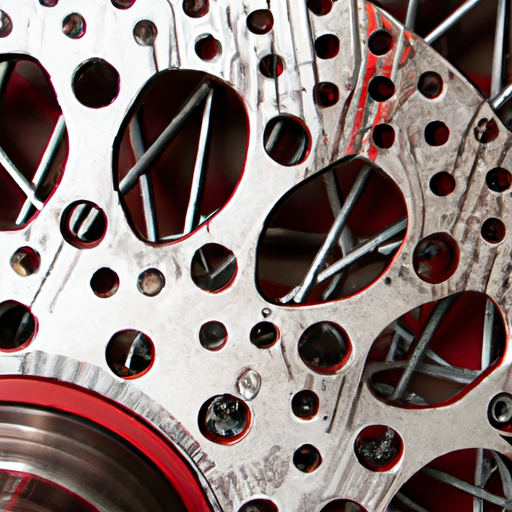How Do I Adjust The Brakes On My Bicycle?
Hey there! Want to learn how to adjust the brakes on your bicycle? If you often find yourself struggling to stop smoothly or hear that annoying squeaking noise every time you hit the brakes, then this article is for you. We’ll walk you through the step-by-step process of fine-tuning your brakes, so you can enjoy a safer and more enjoyable ride. Say goodbye to those nerve-wracking moments of uncertainty and hello to confidently stopping on a dime. Let’s get started, shall we?
Checking Brake Pads
Inspecting the Brake Pads
When it comes to ensuring your safety while riding your bicycle, one crucial element to pay attention to is the brake pads. Regularly inspecting your brake pads is essential to maintain optimal braking performance. To inspect the brake pads, start by looking closely at each pad to check for any signs of wear or damage. If the brake pads are worn down to the metal or have any cracks, it is time for a replacement. Additionally, evaluate the thickness of the brake pad material. If it appears too thin, it is advisable to replace them as well.
Replacing the Brake Pads
If you have determined that your brake pads need replacement, don’t worry! The process is relatively straightforward. Firstly, identify the type of brake system your bicycle has, whether it is rim brakes or disc brakes. Next, remove the wheel to access the brake pads. For rim brakes, you will need to locate the small metal pin holding the brake pad. Carefully remove the pin and slide out the old brake pad. Insert a new brake pad in its place and reinsert the pin. With disc brakes, examine the brake pads for retaining clips or bolts. Remove these and slide out the old pads, then insert the new ones. Finally, reinstall the retaining clips or bolts and put the wheel back on.
Adjusting Brake Cable Tension
Understanding Brake Cable Tension
Brake cable tension refers to the level of tightness in the cable that controls your brakes. Proper brake cable tension is crucial for effective braking. If the tension is too loose, the brakes may feel sluggish or unresponsive. On the other hand, excessive tension can cause the brakes to drag or bind. Understanding the correct brake cable tension for your bicycle is important to ensure a smooth and safe riding experience.
Loosening the Brake Cable
To adjust the brake cable tension, start by locating the barrel adjuster on the brake lever or brake caliper. Gently turn the barrel adjuster counterclockwise to loosen the cable. This will increase the tension on the brake pads, resulting in a more responsive braking system. Make minor adjustments and test the brakes by squeezing the brake lever to assess the feel and responsiveness.
Tightening the Brake Cable
If you find the brake cable tension to be too loose, it is necessary to tighten it. Locate the barrel adjuster and turn it clockwise to tighten the cable. Start with small adjustments until the desired tension is achieved. Remember to test the brakes by squeezing the lever and make further adjustments if needed. Ensure the brake cable is not overly tightened, as this can cause the brakes to bind or not release properly.
Centering the Brake Caliper
Identifying the Brake Caliper
The brake caliper is an essential component of the braking system responsible for holding the brake pads in place and squeezing them against the braking surface to slow down the bicycle. It is crucial to ensure that the brake caliper is properly centered to achieve even and effective braking.
Loosening the Caliper Mounting Bolts
To center the brake caliper, start by locating the caliper mounting bolts. These bolts typically secure the caliper to the front or rear fork of the bicycle. Using an appropriate wrench or Allen key, gently loosen these bolts. It is important to only loosen the bolts without fully removing them.
Centering the Brake Caliper
After loosening the caliper mounting bolts, squeeze the brake lever to activate the brake system. This action will align the caliper with the braking surface. While holding the brake lever, tighten the caliper mounting bolts securely. Release the brake lever and check that the caliper remains centered. If any adjustment is needed, simply repeat the loosening and centering process until the desired alignment is achieved.
Adjusting Brake Pad Alignment
Understanding Brake Pad Alignment
Brake pad alignment plays a crucial role in optimizing brake performance. Proper alignment ensures the brake pads make even contact with the braking surface, resulting in effective and consistent braking. When brake pads are misaligned, it can lead to uneven braking, noise, or reduced stopping power.
Loosening the Brake Pad Mounting Bolts
To adjust the brake pad alignment, start by identifying the brake pad mounting bolts. These bolts secure the brake pads to the brake caliper. Gently loosen these bolts but avoid removing them completely.
Aligning the Brake Pads
After loosening the brake pad mounting bolts, assess the alignment of the brake pads. Adjust the position of the pads as needed to ensure they are parallel to the braking surface. This can be done by carefully pushing or pulling the brake pads within the caliper. Once the alignment is satisfactory, tighten the brake pad mounting bolts securely. Test the brakes to ensure proper alignment and adjust further if necessary.
Checking and Adjusting Brake Lever Reach
Identifying the Brake Lever Reach Adjustment
The brake lever reach adjustment refers to the ability to adjust the distance between the brake lever and the handlebars. This adjustment is essential to accommodate riders with different hand sizes or preferences, ensuring comfort and control while braking.
Loosening the Brake Lever Reach Adjustment Bolt
To adjust the brake lever reach, begin by identifying the brake lever reach adjustment bolt. This bolt is usually located near the brake lever pivot point. Using the appropriate tool, gently loosen the adjustment bolt, allowing the lever to move.
Adjusting the Reach of the Brake Lever
With the brake lever reach adjustment bolt loosened, slide the brake lever inward or outward to achieve the desired reach. Experiment with different positions until you find the most comfortable and ergonomic setting. Once satisfied, tighten the adjustment bolt securely, ensuring the brake lever remains in the desired position. Test the brake lever reach by gripping the handlebars and engaging the brakes.
Inspecting Brake Cables and Housing
Examining the Brake Cables
Properly functioning brake cables are crucial for responsive and reliable braking. Regular inspection of the brake cables helps identify any signs of wear, damage, or stretching that may affect their performance.
Checking the Brake Cable Housing
In addition to inspecting the brake cables themselves, it is essential to examine the brake cable housing. Look for any cracks, fraying, or compression of the housing. Any damage to the housing should be addressed promptly to prevent further issues. If the brake cable housing is compromised, it can affect the smooth operation of the brake cables, leading to poor braking performance.
Lubricating Brake Mechanism
Identifying the Moving Brake Parts
The brake mechanism consists of various moving parts that require lubrication to ensure they operate smoothly. Identifying these parts is essential to obtain optimal brake performance and longevity.
Applying Lubricant to Brake Mechanism
Using a suitable lubricant, apply a small amount to the moving brake parts such as the brake lever pivot, caliper pivots, and any other points of contact. It is crucial not to apply excessive lubricant, as it can attract dirt and debris, adversely affecting the brake’s function. Wipe away any excess lubricant and test the brakes to ensure smooth operation.
Testing and Adjusting Brake Performance
Performing a Brake Test
Once you have completed the brake adjustments and maintenance tasks, it is crucial to test the brake performance to ensure optimal functionality. Find a safe, open space to perform a brake test. Begin by riding at a moderate speed and firmly squeezing the brake levers. Pay attention to how smoothly and quickly the bike slows down or comes to a complete stop. Ensure that both the front and rear brakes are engaging correctly and providing equal stopping power.
Fine-tuning the Brake Adjustment
If you notice any issues during the brake test, such as excessive noise, uneven braking power, or sluggishness, it may be necessary to fine-tune your brake adjustments further. Revisit the specific areas discussed earlier in this article, such as brake pad alignment, cable tension, and caliper centering. Make any necessary adjustments to address the observed issues, repeating the brake test until optimal brake performance is achieved.
Bleeding the Brakes (For Hydraulic Systems)
Understanding Hydraulic Brake System
If your bicycle utilizes hydraulic brakes, it may be necessary to bleed the brakes to maintain optimal performance. Brake bleeding involves removing air bubbles that may have entered the hydraulic system, which can affect braking power and responsiveness. Understanding the hydraulic brake system and the importance of brake bleeding is essential in ensuring safe and reliable braking.
Preparing for Brake Bleeding
Before starting the brake bleeding process, gather the necessary tools, including a bleed kit specifically designed for your hydraulic brakes. Familiarize yourself with the specific bleeding procedure outlined in your bicycle manufacturer’s instructions or consult a professional. Ensure you have the correct brake fluid for your system. Additionally, prepare a clean workspace to prevent contamination of the brake system.
Performing Brake Bleeding
Brake bleeding typically involves attaching a bleed kit to the brake caliper and lever, allowing the removal of air bubbles. Follow the manufacturer’s instructions or professional guidance closely to ensure correct execution of the bleeding process. Usually, this involves manipulating the brake lever and releasing air through the bleed kit. It is important to maintain a steady hand and avoid introducing more air into the system. Once the brake bleeding is complete, test the brakes for functionality and make any necessary adjustments.
Seeking Professional Help
Considering Professional Assistance
While basic brake adjustments and maintenance can typically be performed at home, there may be instances where seeking professional assistance is the most appropriate choice. If you feel unsure or overwhelmed by any aspect of adjusting your bicycle brakes, it is advisable to reach out to a qualified bicycle mechanic or visit a reputable bicycle repair shop.
Visiting a Bicycle Repair Shop
When visiting a bicycle repair shop, knowledgeable staff can provide expert advice and assistance tailored to your specific bicycle and brake system. They possess the tools, experience, and expertise necessary to diagnose and resolve any brake-related issues effectively. Whether it’s a complex brake adjustment or a comprehensive inspection, professional help ensures that your bicycle brakes are in optimal condition for safe and enjoyable rides. Don’t hesitate to take advantage of the services offered by these professionals to maintain the highest standard of safety and performance in your bicycle’s braking system.
In conclusion, knowing how to adjust and maintain your bicycle brakes is crucial for both safety and optimal braking performance. By following the steps outlined in this article, you can inspect and replace brake pads, adjust brake cable tension, center the brake caliper, align brake pads, check brake lever reach, inspect brake cables and housing, lubricate the brake mechanism, test and fine-tune brake performance, bleed hydraulic brake systems, and know when it’s best to seek professional assistance. Remember, regular inspection and maintenance of your bicycle brakes ensure your safety and enhance your overall riding experience.



